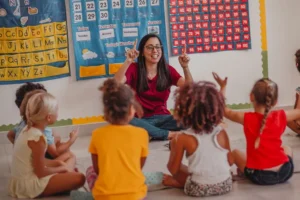How to Meditate with Your Kids
By teaching children meditation and mindfulness skills we help them increase their well-being and enable them to meet the stresses of the world with presence, self-compassion, and openness.
In order to help kids of all ages find their way into practicing mindfulness, it can be helpful to give them an easy definition they can relate to.
A Definition of Mindfulness Meditation for Children
Mindfulness meditation, at its simplest, is paying attention to what is happening in the present moment. It may be what you’re feeling, hearing, or anything else you notice. There’s no special place of calm you have to reach and it’s not about clearing your mind, it’s just an honest and kind look at what you’re experiencing in this moment.
A Mindfulness Practice for Families
By Christopher Willard
One easy way to introduce mindfulness to your children is through informal practices that you can do along with them. Start with a simple kindness meditation—offering good wishes and compassion to others.
- To begin, find a comfortable sitting position. You can even place a hand on the heart. Allow your eyes to close or lower your gaze toward the floor.
- Bring to mind someone who you really respect and look up to, and who really loves you in return.
- notice how you feel as you bring this person to mind.
- Make a kind wish and send it their way. What would make them happy?
- Next, bring to mind someone else you love and care about: A family member, a friend, a beloved colleague. Just bring this person to mind, sending this person a kind wish.
We’ll move from here to a more neutral person. Perhaps someone you don’t know very well: A parent you see occasionally in the pick-up line, a person who delivers your mail, or makes your coffee in the morning. Just bring this person to mind and imagine yourself sending them some kind of kind wish.
- Lastly, bring to mind someone who has frustrated you lately, someone who is a little difficult. Send this last person a kind wish—something nice for them in their life.
- Check in with your mind and body as you conclude this practice. Allow your eyes to open if they’ve been closed. Notice if there’s any shift
Why Teach Mindfulness to Children?
When we teach mindfulness to kids, we give them the tools they need to build confidence, cope with stress, and relate to uncomfortable or challenging moments. The earlier we do so in their young lives, the greater the opportunity to help them cultivate resilience and develop and refine their mindfulness practice as they mature.
Teaching mindfulness to kids can also help shape three critical skills developed in early childhood: paying attention and remembering information, shifting back and forth between tasks, and behaving appropriately with others. These abilities are known as executive functions and they are essential for more advanced tasks like planning, reasoning, problem-solving, and positive social relationships.
There Benefits of Mindfulness for Kids
Studies show that the benefits of mindfulness for kids may include:
- Increased focus, attention, self-control, classroom participation, compassion.
- Improved academic performance, ability to resolve conflict, overall well-being.
- Decreased levels of stress, depression, anxiety, disruptive behavior.



